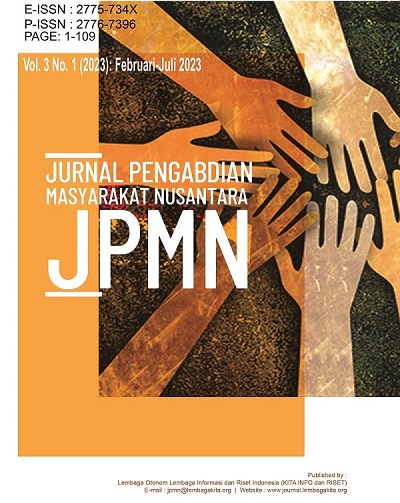Published: 2023-02-25
Education of The 5 Pillars Management Based on Caring For Blood Sugar Levels in Diabetes Mellitus Type II
DOI: 10.35870/jpmn.v3i1.865
Hosnu Inayati, Zakiyah Yasin, Dian Ika Puspitasari, Ahmad Nawawi
- Hosnu Inayati: Wiraraja University , Indonesia
- Zakiyah Yasin: Wiraraja University , Indonesia
- Dian Ika Puspitasari: Wiraraja University , Indonesia
- Ahmad Nawawi: STKIP Sumenep , Indonesia
Article Metrics
- Views 0
- Downloads 0
- Scopus Citations
- Google Scholar
- Crossref Citations
- Semantic Scholar
- DataCite Metrics
-
If the link doesn't work, copy the DOI or article title for manual search (API Maintenance).
Abstract
Diabetes Mellitus is currently still a chronic disease due to high blood sugar levels, cannot be cured and can only be controlled so that sugar levels remain stable and normal. Uncontrolled blood sugar can increase the risk of complications such as gangrene, stroke, coma and death. Batang-Batang Daya Village, Batang-Batang District, Sumenep Regency has 2,371 patients with Type-II Diabetes Mellitus. The number of diabetics is increasing because people do not understand the management of Diabetes Mellitus. Therefore it is necessary to involve all parties such as the village community, local government, community leaders, health workers, and families to assist in controlling blood sugar levels in people with Diabetes Mellitus. The form of community service activities that we carry out are conducting counseling about Diabetes Mellitus and the 5 pillars of management for type-II Diabetes Mellitus sufferers, checking blood glucose levels and blood pressure. The purpose of this community service is that people are able to know from an early age the 5 types of Diabetes Mellitus, the community is able to know from an early age the 5 pillars of management for people with Diabetes Mellitus. The method of carrying out activities is the counseling method and comprehensive blood sugar checks regarding the 5 pillars of Diabetes Mellitus management, namely education, food planning, physical exercise, pharmacological intervention or the use of blood glucose-lowering drugs, and blood sugar.
Keywords
Education ; Pillars of management ; Caring ; Diabetes Mellitus
Article Metadata
Peer Review Process
This article has undergone a double-blind peer review process to ensure quality and impartiality.
Indexing Information
Discover where this journal is indexed at our indexing page to understand its reach and credibility.
Open Science Badges
This journal supports transparency in research and encourages authors to meet criteria for Open Science Badges by sharing data, materials, or preregistered studies.
How to Cite
Article Information
This article has been peer-reviewed and published in the Jurnal Pengabdian Masyarakat Nusantara (JPMN). The content is available under the terms of the Creative Commons Attribution 4.0 International License.
-
Issue: Vol. 3 No. 1 (2023)
-
Section: Articles
-
Published: %750 %e, %2023
-
License: CC BY 4.0
-
Copyright: © 2023 Authors
-
DOI: 10.35870/jpmn.v3i1.865
AI Research Hub
This article is indexed and available through various AI-powered research tools and citation platforms. Our AI Research Hub ensures that scholarly work is discoverable, accessible, and easily integrated into the global research ecosystem. By leveraging artificial intelligence for indexing, recommendation, and citation analysis, we enhance the visibility and impact of published research.




-
-
Masi, G. N., & Mulyadi, N. (2017). Hubungan pola aktivitas fisik dan pola makan dengan kadar gula darah pada pasien diabetes melitus tipe II di poli penyakit dalam rumah sakit pancaran kasih GMIM manado. Jurnal Keperawatan, 5(1). DOI: https://doi.org/10.35790/jkp.v5i1.25151
-
Subandi, E., & Sanjaya, K. A. (2019). Efektifitas modern dressing TERHADAP proses Penyembuhan Luka diabetes melitus TIPE 2. Jurnal Kesehatan, 10(1), 39-50. DOI: https://doi.org/10.38165/jk.v10i1.7
-
-
-
-
Ayuni, N. M. (2020). Efek Buah Naga Merah (Hylocereus Polyrhizus) Terhadap Penurunan Kadar Glukosa Darah Pada Diabetes Tipe 2. Jurnal Ilmiah Kesehatan Sandi Husada, 9(1), 566-572. https://doi.org/10.35816/jiskh.v11i1.350
-
Sofa, A. N., & Rahmawati, A. (2021). Pengaruh Senam Diabetik terhadap Sensitivitas Kaki (Ulkus) dan Kadar Gula Darah Penderita Diabetes Melitus Tipe II. Jurnal Health Sains, 2(11), 1423-1433. DOI: https://doi.org/10.46799/jhs.v2i11.329
-
-
-
-
-
-
-
-

This work is licensed under a Creative Commons Attribution-NonCommercial-NoDerivatives 4.0 International License.
Authors who publish with this journal agree to the following terms:
1. Copyright Retention and Open Access License
Authors retain copyright of their work and grant the journal non-exclusive right of first publication under the Creative Commons Attribution 4.0 International License (CC BY 4.0).
This license allows unrestricted use, distribution, and reproduction in any medium, provided the original work is properly cited.
2. Rights Granted Under CC BY 4.0
Under this license, readers are free to:
- Share — copy and redistribute the material in any medium or format
- Adapt — remix, transform, and build upon the material for any purpose, including commercial use
- No additional restrictions — the licensor cannot revoke these freedoms as long as license terms are followed
3. Attribution Requirements
All uses must include:
- Proper citation of the original work
- Link to the Creative Commons license
- Indication if changes were made to the original work
- No suggestion that the licensor endorses the user or their use
4. Additional Distribution Rights
Authors may:
- Deposit the published version in institutional repositories
- Share through academic social networks
- Include in books, monographs, or other publications
- Post on personal or institutional websites
Requirement: All additional distributions must maintain the CC BY 4.0 license and proper attribution.
5. Self-Archiving and Pre-Print Sharing
Authors are encouraged to:
- Share pre-prints and post-prints online
- Deposit in subject-specific repositories (e.g., arXiv, bioRxiv)
- Engage in scholarly communication throughout the publication process
6. Open Access Commitment
This journal provides immediate open access to all content, supporting the global exchange of knowledge without financial, legal, or technical barriers.
